///Slanted~~Picture///
by Bob Roberts
Wells-Gardner K4600
*(HIGH VOLTAGE!! CAUTION MUST BE USED DURING ADJUSTMENT!!)*
Symptom:
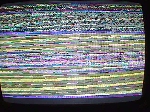 The screen has horizontal bans of color like a barber pole or
maybe almost straightened up, but not quite, so that the picture
is slanted. Some pcbs may work fine, while others don't. Treble
pic images stable on screen. Just not enough H range period & a
host of other complaints right up to a bend in the top of picture.
The screen has horizontal bans of color like a barber pole or
maybe almost straightened up, but not quite, so that the picture
is slanted. Some pcbs may work fine, while others don't. Treble
pic images stable on screen. Just not enough H range period & a
host of other complaints right up to a bend in the top of picture.
Cure:
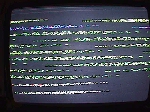 The horizontal frequency has drifted off from center. Locate the
horizontal hold control on the vertical pc card on the right hand
side of the chassis. It is the white knob on the bottom under
the long protruding black knob (V. hold). Set it to it's mechanical
center & leave it.
The horizontal frequency has drifted off from center. Locate the
horizontal hold control on the vertical pc card on the right hand
side of the chassis. It is the white knob on the bottom under
the long protruding black knob (V. hold). Set it to it's mechanical
center & leave it.
In the center of this same vertically mounted pc card, you will
see a shiny metal square can about 1 inch down from the top.
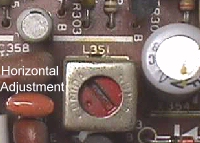 Looking into it you will see a red screwdriver slot. You'll need
a 12" plastic screwdriver to feed through the hole on the metal
chassis frame, that lines up with this screw slot in the can &
adjust it until the picture straightens up. If you go the wrong way
and the picture goes out altogether, don't worry, just go back in
the opposite direction for a few turns & turn the monitor off for
a minute & then back on. This resets your auto-shutdown circuit.
Now you can continue going in the right direction until the picture
is upright.
Looking into it you will see a red screwdriver slot. You'll need
a 12" plastic screwdriver to feed through the hole on the metal
chassis frame, that lines up with this screw slot in the can &
adjust it until the picture straightens up. If you go the wrong way
and the picture goes out altogether, don't worry, just go back in
the opposite direction for a few turns & turn the monitor off for
a minute & then back on. This resets your auto-shutdown circuit.
Now you can continue going in the right direction until the picture
is upright.
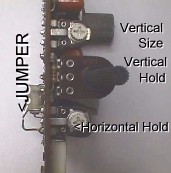 This should solve your problem & if you use your cabinet as a
multi-game cab, you should try several of your pcbs in the game
& adjust the small white horizontal knob to a position where
any of the pcbs will plug n play.
This should solve your problem & if you use your cabinet as a
multi-game cab, you should try several of your pcbs in the game
& adjust the small white horizontal knob to a position where
any of the pcbs will plug n play.
If you still are having trouble with sync circuits, some V/H bds
require a jumper across C315 eliminating it from the circuit when
used with certain game pcbs, while others need C315 in circuit.
There is usually a bare wire jumper on the solder side of C315 that
can be cut open or tacked together as needed.
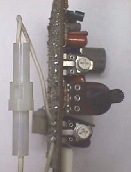 A couple of wires attached to these points with a Molex 1 pos
connector in the center would be a good idea on a cab that is
used as a multi-cab. Once these have been installed, you can
run a pair of wires up to the coin door & mount a switch to take
this cap in & out of circuit if you have a front drawer system
cabinet and don't need to be in the back of the cabinet for any
reason. Be sure to use the Molex 1 pos connector (M & F) to plug
your remote switch wires to the V/H card by interrupting the
bypass already installed. This ensures that it can easily revert
back to the card plug to use it for testing other monitors or
for any reason that you would remove it, it would still operate
stand alone & without you having to fish all your coin door wiring
out with it.
A couple of wires attached to these points with a Molex 1 pos
connector in the center would be a good idea on a cab that is
used as a multi-cab. Once these have been installed, you can
run a pair of wires up to the coin door & mount a switch to take
this cap in & out of circuit if you have a front drawer system
cabinet and don't need to be in the back of the cabinet for any
reason. Be sure to use the Molex 1 pos connector (M & F) to plug
your remote switch wires to the V/H card by interrupting the
bypass already installed. This ensures that it can easily revert
back to the card plug to use it for testing other monitors or
for any reason that you would remove it, it would still operate
stand alone & without you having to fish all your coin door wiring
out with it.
Yes, I see the Q coming.....can I move the rest of the controls
up front?
Yes. If you have lots of time on your hands, you can unsolder
the other controls & mount them on a perf board up near the coin
door & run a shielded multi-wire cable to the V/H card. I would
definitely break this cable as it leaves the V/H card with a
Molex multi-connector to facilitate monitor repair.
While you are here, you may as well know about a couple other
quirks of the K4600. If you are still experiencing horizontal
difficulties, or vertical for that matter, these 2 plug in
cards....actually 3 as the regulator card to the far left, also
plugs into the main....often have cold solder joints on both
the header pins on the main board & the card connectors. To
remedy this you need to flow a bit of new solder into the old
to soften it for removal. The little $5 solder sucker is the
quickest way to clean this old solder out. After you have a few pins
cleaned, you can flow some new solder onto them before proceeding,
to maintain stability to the end.
Another quirk that is often overlooked is the cap at position
C614 on the main board. 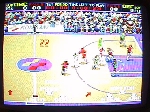 This cap bridges the pincusion xformer
and when it grows weak it causes the picture to appear
trapezoidal, or what techs call "hourglass" or "keystone".
The center of the pic can bow inward )( or outward ( ),
hence the 2 terms.
The reason it is overlooked so much, is that in their infinite
wisdom of design, they chose to mount this under the V/H card
between the 2 connectors, forcing the radial cap to be mounted
with extra long leads & then bent to a laying out-of-the-way
position on the main board to allow the V/H card to plug in.
This cap bridges the pincusion xformer
and when it grows weak it causes the picture to appear
trapezoidal, or what techs call "hourglass" or "keystone".
The center of the pic can bow inward )( or outward ( ),
hence the 2 terms.
The reason it is overlooked so much, is that in their infinite
wisdom of design, they chose to mount this under the V/H card
between the 2 connectors, forcing the radial cap to be mounted
with extra long leads & then bent to a laying out-of-the-way
position on the main board to allow the V/H card to plug in.
If you encounter the treble image or double image when changing out
a monitor other than the 4600, your chances are very good that
you have a medium resolution monitor rather than a standard
resolution monitor, as the 4600 is the only CGA that I've seen
capable of going that far off frequency to exhibit that symptom
prior to shutdown.
Happy Gaming...........
|
Help Page Index Big Bear's Bulletin Board
Site Index
 The screen has horizontal bans of color like a barber pole or
maybe almost straightened up, but not quite, so that the picture
is slanted. Some pcbs may work fine, while others don't. Treble
pic images stable on screen. Just not enough H range period & a
host of other complaints right up to a bend in the top of picture.
The screen has horizontal bans of color like a barber pole or
maybe almost straightened up, but not quite, so that the picture
is slanted. Some pcbs may work fine, while others don't. Treble
pic images stable on screen. Just not enough H range period & a
host of other complaints right up to a bend in the top of picture. The horizontal frequency has drifted off from center. Locate the
horizontal hold control on the vertical pc card on the right hand
side of the chassis. It is the white knob on the bottom under
the long protruding black knob (V. hold). Set it to it's mechanical
center & leave it.
The horizontal frequency has drifted off from center. Locate the
horizontal hold control on the vertical pc card on the right hand
side of the chassis. It is the white knob on the bottom under
the long protruding black knob (V. hold). Set it to it's mechanical
center & leave it. Looking into it you will see a red screwdriver slot. You'll need
a 12" plastic screwdriver to feed through the hole on the metal
chassis frame, that lines up with this screw slot in the can &
adjust it until the picture straightens up. If you go the wrong way
and the picture goes out altogether, don't worry, just go back in
the opposite direction for a few turns & turn the monitor off for
a minute & then back on. This resets your auto-shutdown circuit.
Now you can continue going in the right direction until the picture
is upright.
Looking into it you will see a red screwdriver slot. You'll need
a 12" plastic screwdriver to feed through the hole on the metal
chassis frame, that lines up with this screw slot in the can &
adjust it until the picture straightens up. If you go the wrong way
and the picture goes out altogether, don't worry, just go back in
the opposite direction for a few turns & turn the monitor off for
a minute & then back on. This resets your auto-shutdown circuit.
Now you can continue going in the right direction until the picture
is upright. This should solve your problem & if you use your cabinet as a
multi-game cab, you should try several of your pcbs in the game
& adjust the small white horizontal knob to a position where
any of the pcbs will plug n play.
This should solve your problem & if you use your cabinet as a
multi-game cab, you should try several of your pcbs in the game
& adjust the small white horizontal knob to a position where
any of the pcbs will plug n play. A couple of wires attached to these points with a Molex 1 pos
connector in the center would be a good idea on a cab that is
used as a multi-cab. Once these have been installed, you can
run a pair of wires up to the coin door & mount a switch to take
this cap in & out of circuit if you have a front drawer system
cabinet and don't need to be in the back of the cabinet for any
reason. Be sure to use the Molex 1 pos connector (M & F) to plug
your remote switch wires to the V/H card by interrupting the
bypass already installed. This ensures that it can easily revert
back to the card plug to use it for testing other monitors or
for any reason that you would remove it, it would still operate
stand alone & without you having to fish all your coin door wiring
out with it.
A couple of wires attached to these points with a Molex 1 pos
connector in the center would be a good idea on a cab that is
used as a multi-cab. Once these have been installed, you can
run a pair of wires up to the coin door & mount a switch to take
this cap in & out of circuit if you have a front drawer system
cabinet and don't need to be in the back of the cabinet for any
reason. Be sure to use the Molex 1 pos connector (M & F) to plug
your remote switch wires to the V/H card by interrupting the
bypass already installed. This ensures that it can easily revert
back to the card plug to use it for testing other monitors or
for any reason that you would remove it, it would still operate
stand alone & without you having to fish all your coin door wiring
out with it. This cap bridges the pincusion xformer
and when it grows weak it causes the picture to appear
trapezoidal, or what techs call "hourglass" or "keystone".
The center of the pic can bow inward )( or outward ( ),
hence the 2 terms.
The reason it is overlooked so much, is that in their infinite
wisdom of design, they chose to mount this under the V/H card
between the 2 connectors, forcing the radial cap to be mounted
with extra long leads & then bent to a laying out-of-the-way
position on the main board to allow the V/H card to plug in.
This cap bridges the pincusion xformer
and when it grows weak it causes the picture to appear
trapezoidal, or what techs call "hourglass" or "keystone".
The center of the pic can bow inward )( or outward ( ),
hence the 2 terms.
The reason it is overlooked so much, is that in their infinite
wisdom of design, they chose to mount this under the V/H card
between the 2 connectors, forcing the radial cap to be mounted
with extra long leads & then bent to a laying out-of-the-way
position on the main board to allow the V/H card to plug in.